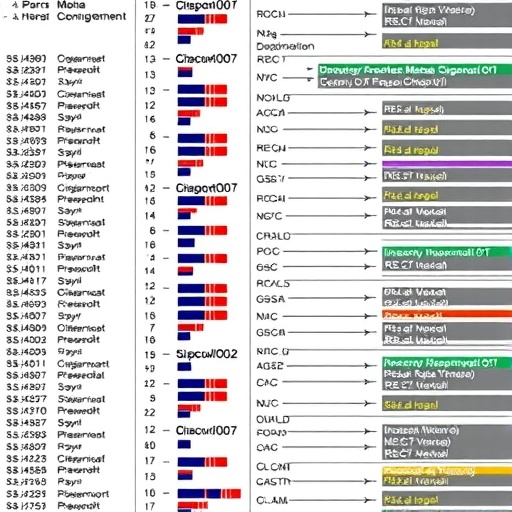In a groundbreaking study published in the Journal of Translational Medicine, researchers from leading medical institutions have unveiled a revolutionary advance in the realm of infectious disease diagnostics. Their research, focusing on an ultra-broad hybrid capture-based targeted next-generation sequencing (NGS) technology, boasts the potential to dramatically enhance the detection of circulating free DNA (cfDNA) from pathogens in plasma samples of patients suffering from bloodstream infections. This innovative technique could reshape how clinicians diagnose and manage serious infections, providing them with tools to identify pathogens more swiftly and accurately.
The traditional methods of diagnosing bloodstream infections have often been constrained by various limitations, including time delays and the inability to detect certain pathogens. The standard blood culture tests can be time-consuming, taking often several days before identifying the responsible microorganism. Furthermore, there is an inherent risk of missing fastidious organisms or those that are non-culturable. The research illuminates a future where rapid, precise pathogen detection can emerge as a front line in patient care, enhancing the management of such critical conditions.
At the heart of this study is the concept of hybrid capture-based sequencing, an excellent illustration of how advanced genomic technologies can be applied to infectious diseases. Using this technique, the researchers were able to target and sequence specific regions of pathogen cfDNA present in blood plasma. The selective enrichment method allows for enhanced sensitivity, making it feasible to identify even low-abundance pathogens which are often overlooked by traditional methodologies.
Throughout the study, the authors meticulously detail the framework of their methodological approach. By employing hybrid capture NGS, they created a comprehensive sequencing panel that could capture an extensive range of pathogens, including bacteria and viruses, in a single assay. This multiplexing capability not only saves time but also reduces costs associated with performing multiple separate tests, which can be a significant burden in clinical laboratory settings.
Furthermore, the study highlights the efficiency of this innovative NGS technique in its ability to provide results within a much shorter timeframe than traditional methods. In a clinical setting, this speed of diagnosis can be a game changer, especially for critically ill patients whose treatment requires immediate and accurate identification of the causative agents. Rapid detection allows for prompt initiation of targeted antibacterial or antiviral therapies, potentially improving patient outcomes significantly.
One of the key revelations from the study is the technique’s capacity to overcome challenges associated with the heterogeneity often seen in bloodstream pathogens. The authors argue that the ability to comprehensively profile the plasma cfDNA opens avenues for understanding the infectious disease landscape at both the individual and population levels. The broad detection spectrum of this methodology promises to facilitate a more nuanced understanding of mixed infections, poly-microbial infections, and the role of non-culturable organisms in bloodstream infections.
Moreover, the implications for outbreak detection and monitoring should not be underestimated. Surveillance systems that incorporate this technology could allow for a timely assessment of emerging pathogens, particularly in an era where antibiotic resistance poses a significant threat to global health. By enabling real-time tracking of pathogen evolution and spread, public health organizations can better allocate resources and implement necessary interventions.
The study’s authors also emphasize the importance of clinical validation in enhancing the credibility and applicability of their findings. Preliminary results showcased that the ultra-broad hybrid capture-based NGS outperformed conventional diagnostic methods significantly in terms of pathogen detection rates. These initial validations provide a promising basis for further exploration within larger cohorts to ascertain the reliability and reproducibility of the results across diverse patient demographics.
Ethics and regulatory considerations surrounding the implementation of such advanced techniques in clinical settings are also touched upon in this research. The need for stringent regulatory frameworks must be emphasized as the deployment of cutting-edge technologies can pose challenges related to patient privacy, data security, and the ethical implications of using genomic information in healthcare. Furthermore, continuous engagement with regulatory bodies will be vital in ensuring these methodologies meet public health standards and can be adopted safely within everyday practice.
In conclusion, the findings presented by Wei et al. signify a leap forward in the fight against bloodstream infections. The ultra-broad hybrid capture-based targeted NGS technology stands as a testament to the potential of sophisticated genomic methods to not only diagnose infections with unprecedented accuracy but also enhance the overall quality of patient care. As the medical community begins to embrace these innovative approaches, there is hope that such advances may dramatically reshape the prognosis of individuals battling severe infections, ultimately leading to improved survival rates and quality of life.
The implications for healthcare practitioners, researchers, and policymakers are profound, making it essential to further disseminate these findings and catalyze the translation of laboratory advancements into clinical application. With continued innovation and collaborative efforts in the field of infectious diseases, the vision of rapid, accurate, and accessible diagnostics is increasingly becoming a tangible reality that can save lives.
Subject of Research: Bloodstream infections and pathogen detection through cfDNA analysis.
Article Title: Ultra-broad hybrid capture-based targeted next-generation sequencing for sensitive plasma pathogen cfDNA detection in bloodstream infections.
Article References:
Wei, M., Ai, X., Gu, D. et al. Ultra-broad hybrid capture-based targeted next-generation sequencing for sensitive plasma pathogen cfDNA detection in bloodstream infections.
J Transl Med 23, 1203 (2025). https://doi.org/10.1186/s12967-025-07258-9
Image Credits: AI Generated
DOI: 10.1186/s12967-025-07258-9
Keywords: bloodstream infections, pathogen detection, cfDNA, next-generation sequencing, hybrid capture, diagnostic technology.
Tags: advanced methods for detecting bloodstream pathogensbloodstream infection diagnosticscfDNA analysis in clinical settingsgenomic technologies in healthcarehybrid capture-based sequencing technologyimproving patient care through diagnosticsinnovative techniques in infectious disease managementnext-generation sequencing for infectionsovercoming limitations of blood culture testspathogen detection in blood plasmarapid pathogen identification methodstransformative research in medical diagnostics





